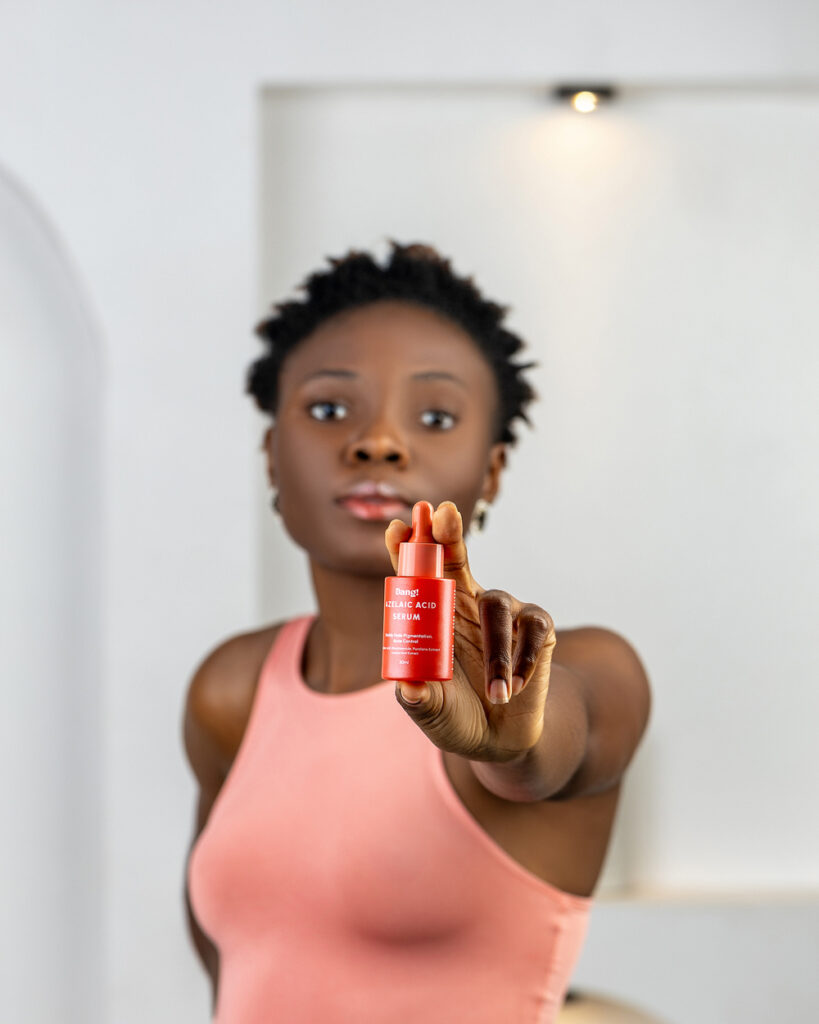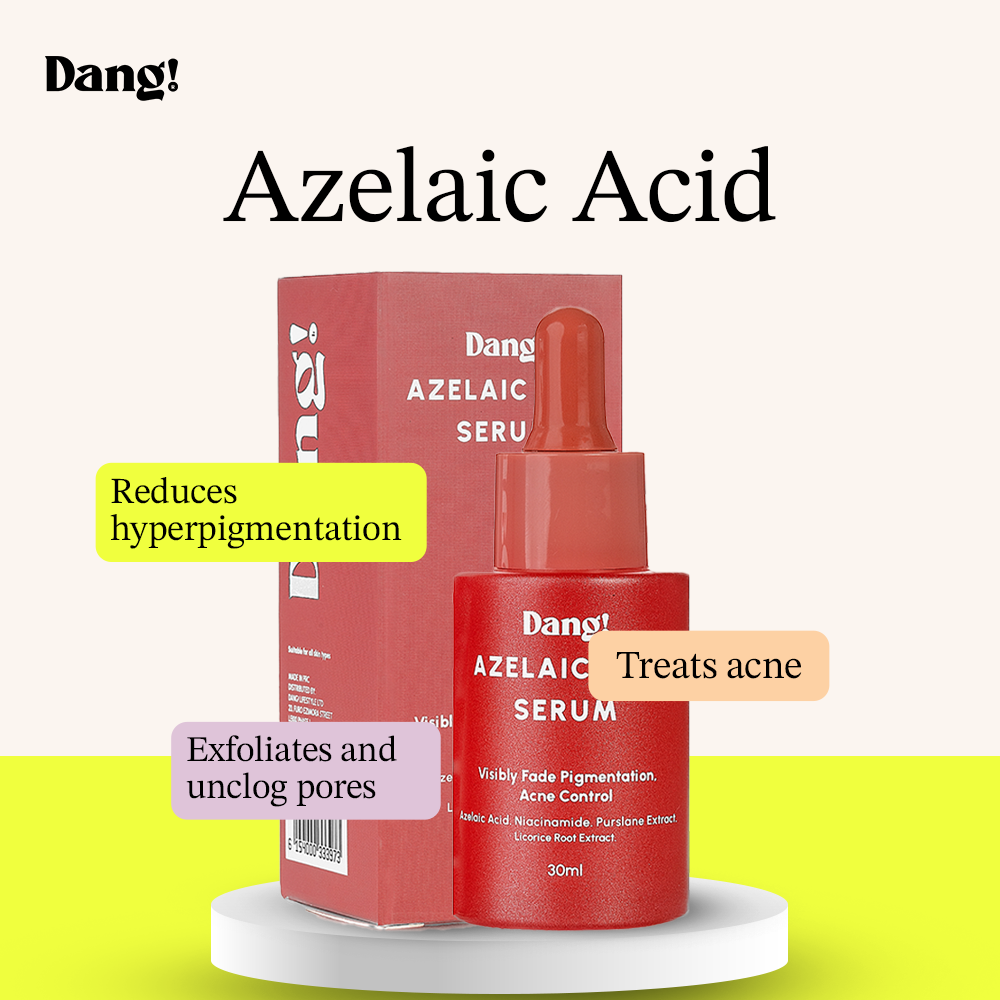
Spend ₦300K+, Get 20% Off Spa Treatments!
Up to 40% Off Sitewide. June 30th - July 7th.
Up to 40% Off Sitewide. June 30th - July 7th.
Up to 40% Off Sitewide. June 30th - July 7th.

The benefits of azelaic acid serum are numerous. Perhaps you’ve heard many things about this skincare ingredient, and now you’re wondering how true they are.
You see, my skincare bestie, incorporating azelaic acid into your routine is a no-brainer, especially if you have melanin-rich skin. This skincare product can transform your skin, especially if you’re dealing with skincare concerns like stubborn acne, redness, or hyperpigmentation.
Curious about how this multitasking skincare ingredient can transform your skin? Let’s dive into the science, benefits, and best ways to incorporate azelaic acid serum into your regimen.
Azelaic acid helps reduce inflammation, combat acne, and even out pigmentation by gently unclogging pores and inhibiting melanin production. With regular use over 4–8 weeks, it can transform your skin into a clearer, more radiant version of itself.
Azelaic acid is a naturally occurring compound in grains like barley, wheat, and rye. It’s a dicarboxylic acid, a unique type of acid with antimicrobial and anti-inflammatory properties.
That sounds interesting, right?
Just a minute. I know what you’re thinking. So, could I eat all these foods that naturally contain this ingredient to get all the benefits for my skin?
Well, not exactly.
You see, while azelaic acid is found naturally in grains like barley, wheat, and rye, eating these foods won’t provide enough azelaic acid to deliver the skincare benefits you’d get from a topical serum.
Low Concentration in Food: The amount of azelaic acid in these grains is relatively small, and the body doesn’t absorb it in the quantities necessary to directly impact your skin’s health.
Topical Application is More Effective: Azelaic acid serums are formulated to deliver concentrated doses directly to the skin, where they can interact with specific skin cells and processes. Eating grains won’t allow azelaic acid to target acne, inflammation, or pigmentation in the same way.
Skincare Requires More Than One Ingredient: While eating a balanced diet that includes grains can support overall health (including your skin), many factors influence skin health, such as hydration, sun protection, and other topical treatments. All of these factors are considered when formulating skincare products.
Overall, whole grains are excellent for your general well-being, but for the powerful skincare benefits azelaic acid offers, you’ll need a topical product. This ensures the azelaic acid is delivered where it works best: your skin.

Though originally found in grains, azelaic acid used in skincare products is synthesised through a refined production process to ensure its purity and stability. This ensures it’s safe, effective, and potent enough to address a wide range of skin concerns.
To deliver all the amazing goodies for your skin, azelaic acid works in several ways, targeting several underlying factors to improve your skin. Here’s how it works;
Incorporating azelaic acid into your routine can provide the following benefits for your skin;
Azelaic acid is an effective solution for mild to moderate acne. It reduces swelling, kills acne-causing bacteria, and minimises the appearance of post-acne marks. Plus, its non-comedogenic nature ensures it won’t clog your pores.
Struggling with rosacea? Azelaic acid can be a game-changer.
It helps reduce the redness and bumps associated with this chronic condition by calming inflammation and strengthening the skin barrier.
Using azelaic acid for hyperpigmentation in melanin-rich skin, especially melasma and post-inflammatory hyperpigmentation, can be incredibly beneficial. It works by inhibiting tyrosinase, the enzyme responsible for melanin production, which helps minimize excess pigment and visibly fade dark spots over time.
What makes azelaic acid even more powerful is its anti-inflammatory properties. It helps calm irritated skin, reduce redness, and interrupt the cycle of inflammation that often triggers or worsens hyperpigmentation in darker skin tones.
Perhaps most impressively, azelaic acid can selectively target abnormal melanocytes (the pigment-producing cells responsible for melasma) without damaging healthy skin cells, making it a gentle yet potent option for managing discolouration in melanin-rich complexions.
Azelaic acid contains antioxidant properties which offer protection against free radicals. Free radicals are atoms that contribute to several diseases and premature ageing.
This makes it an excellent addition to anti-ageing routines.
Azelaic acid’s antibacterial properties extend to balancing the skin’s microbiome, promoting healthy, resilient skin.

Looking to incorporate this ingredient into your skincare routine? Look no further than the Dang! Azelaic Acid Serum- a uniquely crafted solution designed to transform your skin’s appearance.
This potent serum combines 10% azelaic acid to diminish hyperpigmentation and combat acne, 5% niacinamide to enhance the skin barrier and reduce redness, purslane extract for its powerful antioxidant and anti-ageing properties, and liquorice root extract to brighten and soothe irritation.
Together, these ingredients work synergistically to inhibit melanin production, resulting in a more even and radiant skin.
Experience the transformative power of The Dang Azelaic Acid Serum and unveil clearer, brighter, and healthier-looking skin.
Here’s how to use this ingredient in your daily routine;
You can use azelaic acid during the day or at night. Applying it in the morning ensures you reap its antioxidant benefits while protecting your skin throughout the day.
However, if you have sensitive skin, applying it in the daytime may not be ideal for you. You can use vitamin C serum in the daytime to get the antioxidant benefits and protect your skin from harmful UV rays, and use azelaic acid for nighttime.
Remember to always listen to your skin and always finish off your morning routine with an SPF 50 sunscreen.
Azelaic acid is a gentle exfoliant and may be suitable for everyday use, depending on the concentration. Lower concentrations (around 10%) are often gentle enough for daily use, while higher concentrations (15–20%) might be best used once or twice a week or as directed by your dermatologist.
The key is to start slowly. If you’re new to azelaic acid, begin with once or twice a week and monitor your skin’s reaction. If your skin tolerates it well, you can gradually increase usage.
Choosing between two great products can be tough. Vitamin C and azelaic acid are staples in the skincare world.
So, I get why this question may be coming up. Here’s the thing: one isn’t better than the other.
Both azelaic acid and vitamin C are fantastic skincare ingredients, but they serve slightly different purposes. Which one is “better” depends on your specific skin concerns and goals.
Here’s what you need to know about these two skincare heroes.
Azelaic acid is a powerhouse for targeting acne, rosacea, and hyperpigmentation. It has antimicrobial and anti-inflammatory properties, making it great for soothing redness and irritation while unclogging pores.
It’s also very gentle if not the only gentle skincare active, making it suitable for sensitive skin types. If you’re dealing with breakouts, uneven skin tone, or redness, azelaic acid is a fantastic option.
Vitamin C is your go-to for brightening and protecting your skin. As an antioxidant, it neutralises free radicals caused by sun exposure and pollution, preventing premature ageing. It also boosts collagen production and fades dark spots, leaving your skin glowing and more even-toned. However, it can sometimes be irritating for sensitive skin, especially in higher concentrations.
It all depends on your skincare goals and the specific skin concern you’re struggling with.
But why use one when you can have the best of both worlds? Yes, you can use both in your skincare routine.
Alternate both products, e.g., vitamin C in the morning and azelaic acid at night. Always remember to use sunscreen in the morning, regardless of which product you use, to maximise protection and results!
Azelaic acid is one of the versatile ingredients that pair well with other ingredients.
Here’s a list of products that can be used with azelaic acid.
Ultimately, combining suitable skincare ingredients in your routine can help you address multiple skincare issues and maximise the results you get.
Azelaic acid is generally a versatile and gentle ingredient that works well with many other skincare actives. However, to avoid irritation or compromised results, there are certain combinations you should approach with caution.
Ingredients like glycolic acid, salicylic acid, and lactic acid in high concentrations can increase the risk of irritation when layered with azelaic acid.
Why? Both azelaic acid and AHAs/BHAs exfoliate the skin, so using them together can lead to over-exfoliation, dryness, redness, or sensitivity.
So, if you must use them with azelaic acid, use them on alternate days or use azelaic acid in the morning and AHAs/BHAs at night.
Retinoids are powerful exfoliators and can cause dryness and irritation, especially when combined with azelaic acid.
Why? The skin may become overwhelmed by these actives, resulting in irritation or a weakened skin barrier.
How to use them: Alternate use. Azelaic acid one day and retinoids the next, or use one in the morning (azelaic acid) and the other at night (retinoids).
Combining this acid with retinoids can be quite tricky. See this post on how to combine azelaic acid and tretinoin to discover the right way to combine these ingredients.
Benzoyl peroxide is an acne-fighting powerhouse, but it’s quite harsh and drying on the skin.
Why: Using it alongside azelaic acid may overstrip the skin and lead to irritation.
How to use them: Use benzoyl peroxide as a spot treatment only, and use azelaic acid on the day you aren’t using azelaic peroxide.
Vitamin C in its pure form, especially at higher concentrations (15% or more), can irritate the skin when combined with azelaic acid.
Why: Both ingredients are active treatments, and layering them might cause sensitivity or disrupt the effectiveness of each one.
How to use them: Use vitamin C in the morning and azelaic acid at night for optimal results.
Physical scrubs or exfoliating brushes can damage the skin barrier when combined with azelaic acid’s mild exfoliating properties.
Why: Over-exfoliation can lead to irritation and worsen skin concerns.
Skip physical exfoliants if azelaic acid is part of your routine, as it provides gentle exfoliation on its own. If you’re struggling with dull skin and need to exfoliate, opt for chemical exfoliants like mandelic acid.
When using azelaic acid, avoid layering too many active ingredients at once, especially those that exfoliate or increase skin sensitivity. If you’re unsure how your skin will react, introduce one product at a time and do a patch test before combining ingredients.
Overall, when in doubt, simplify your routine and consult a skincare professional if you have specific concerns.
One common question we get asked often is if azelaic acid causes skin purging. When using azelaic acid, you may experience mild irritation, dryness, or slight peeling. To reduce the chances of this happening, start by using it once per week and gradually increase usage to 2-3 times weekly to allow your skin to adjust.
Azelaic acid is a gentle and well-tolerated skincare ingredient that’s suitable for most skin types. However, those with severe allergies should consult a dermatologist before use.
The azelaic acid serum is a true multitasker in skincare, offering solutions for acne, rosacea, hyperpigmentation, and more, all while being gentle and suitable for most skin types. If you’ve been searching for an effective, dermatologist-recommended ingredient that delivers visible results, it’s time to give azelaic acid a try.
Explore the Dang! Azelaic acid serum and watch your skin transform!
Azelaic acid is best used at night. This is because skincare acids like this increase your skin’s sensitivity to the sun. Therefore, use only at night and never skip using sunscreen during the day.
Azelaic acid offers gentle exfoliating properties on its own by helping to unclog pores and promote cell turnover. Because of this, you typically do not need to add another exfoliating agent into your routine while using azelaic acid.
Combining multiple exfoliants can increase the risk of irritation or sensitivity. If you feel the need for additional exfoliation, it’s best to use a chemical exfoliant like mandelic acid and use it occasionally, once a week or biweekly.
The trick is to always listen to your skin’s feedback.
Absolutely. Many azelaic acid formulations are designed to be left on the skin overnight to allow the ingredients to work continuously. When used as part of your nighttime skincare routine, azelaic acid can help reduce inflammation and improve skin texture while you sleep.
Just be sure to follow the product’s instructions, and if you’re mixing it with other actives, consider how they might interact. A gentle cleanser in the morning is usually all that’s needed to remove any residue.
Most users begin to notice improvements in skin clarity, reduced redness, and fewer blemishes after about 4 to 8 weeks of consistent use. However, individual results can vary depending on your skin’s condition, the concentration of the product, and your overall skincare routine.
For conditions like melasma or rosacea, it might take a bit longer to see dramatic improvements. If you’re not seeing any changes after a couple of months, it may be worth consulting your dermatologist to adjust your routine or consider other complementary treatments.
Some users report a temporary increase in breakouts or irritation, a phenomenon often referred to as a “purge.” This purge phase is thought to occur as the active ingredients accelerate cell turnover, bringing underlying impurities to the surface.
If it happens, it typically lasts about 2 to 4 weeks. However, not everyone experiences a purge, and its presence isn’t necessarily a sign that the product isn’t working. If you find that the breakout persists beyond this period or if you experience severe irritation, it might be a good idea to pause use and consult with your dermatologist.
In stock
$24.00 Original price was: $24.00.$22.40Current price is: $22.40.
In stock
$38.00 Original price was: $38.00.$35.50Current price is: $35.50.

DANG! LIFESTYLE
Connect with us
Exclusive offers, a heads up on new things, and sightings of Dang! #DangLifestyle
Customer Support
+2349073332942
Copyright © 2025